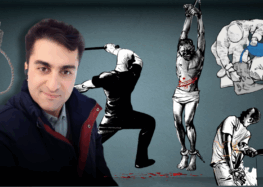Green Ribbon Evidence of Crime in a Prisoner’s Case
An attorney representing those arrested during the post election protests told the International Campaign for Human Rights in Iran that during the visits he has had to the Revolutionary Courts, he has observed cases where a green bracelet or ribbon were used as evidence of a crime in the suspects’ files.
Referring to the generality of charges made against many of the arrested protesters, especially those arrested on Ashura Day, he said: “In one of my visits to court, quite by accident, I was able to see several cases in which things such as green ribbons or green bracelets were attached to the file as “criminal evidence.” In one case, pictures taken on someone’s cell phone during the protests was developed and affixed to the file as crime evidence. Of course, I don’t know how they could use such things as criminal evidence for accusing detainees. Taking pictures of public places where hundreds of people are present, during the day and with a cellular phone is not a crime and people cannot be arrested for this.”
This attorney to political prisoners added: “Unfortunately, the judges in political cases consider everything other than the law. In none of the trials I have attended, has there been any consideration for the defense I have provided to refute the charges against my clients. Only what the Prosecutor has announced as charges or whatever the Ministry of Intelligence authorities or IRGC interrogators have said have been used and confirmed as the last word. However, if only they pay attention to what the suspects are saying in denying the charges and if they read the defense bills attorneys like me are offering, and if those arrested are treated according to the law, not only all of them must be released as soon as possible, they should all be compensated for their baseless arrests and the time they have spent in prison and the physical and psychological damages caused to them and their families. Those who arrested and interrogated them must compensate for these damages.”
He told the Campaign: “Unfortunately, cases of those detained are reviewed behind the scenes and attorneys and the media have very little access to the cases. If only everyone could see based on what invalid evidence and documents the detainees, most of whom are under the age of 30, have received prison sentences between 6 months to five years, an enormous laughingstock and a huge scandal for the Judiciary would be exposed. I mean either these judges are so illiterate that they cannot recognize these cases, or they are so political that they are doing this to intimidate people, closing their eyes on the law. In both cases,






